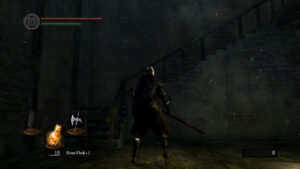Dark Souls: Monsters that Aren’t Zombies
Earlier, I said that every single enemy in Dark Souls other than the bosses (which tend to be various kinds of demon or dragon) is a zombie, or “Undead”. This turns out not to be true. I suppose I should have known: very early on, you get to meet skeleton and giant rat enemies. But skeletons are, from a certain point of view, just zombies in a more advanced state of decay, and the rats are diseased-looking enough to plausibly be zombie rats. And when you meet dark knights in full armor, they’re not exactly confirmed zombies, but in context, when the vast majority of things you’ve encountered are zombies, it’s a natural first assumption.
But once you get into the Darkroot Garden and areas beyond it, this stance becomes more difficult to maintain. It starts with some sort of plant-people, with spiky bushes growing out of their heads and bodies, who attack with vines. That could still be a kind of zombie, I guess? Just… zombies that spent so long lying still that plants started growing in them. In an adjacent zone, there are these crystal beings, basically big lumps of quartz with stubby arms and legs. This seems even less likely to be a kind of zombie, but the mere fact that it’s humanoid, that it moves like a person, means that the possibility of a zombie crystallizing at least crossed my mind. Giant figures in stone armor, lying on the ground and covered in patches of moss, that stand up as you approach: Giant zombies? No, these have lore attached to them. When they drop a weapon or a shield, its description states that they’re stone statues, animated by sorcery.
And past that, you get some creatures that aren’t even a little bit zombie-like. There are these bright red manta-ray-like creatures that crawl along the forest floor and attack you with froglike tongues. The Valley of the Drakes has exactly what it says on the tin. The sewers under the ruined city have amorphous slimes and weird leaping bug-things. Apart from the slimes and the rats, though, there’s a general tendency towards the humanoid. If you ignore the wings, the drakes have suspiciously human proportions, and walk upright when they’re not flying. When the manta rays die, they flip over to reveal incongruously human arms and legs, which is at least consistent with pictures of baby manta rays you can find online. I suspect it’s all due to motion capture.
Oh, and those skeletons? Turns out they’re not Undeads. As I’ve said before, an Undead in this setting is a person marked by a curse that makes them come back with diminished humanity when they die. The skeletons are just ordinary bones animated by a necromancer.
 Comments(0)
Comments(0)
